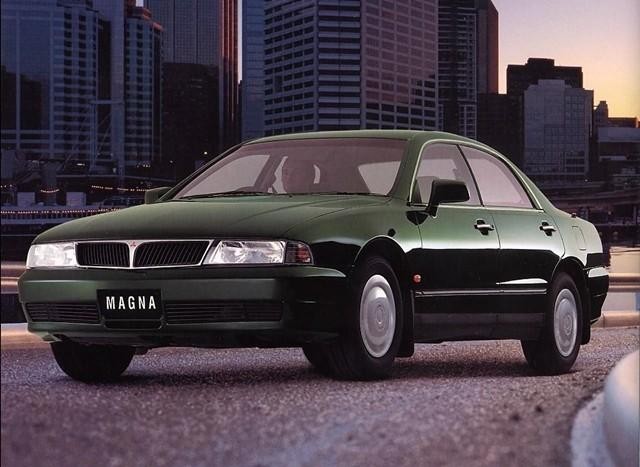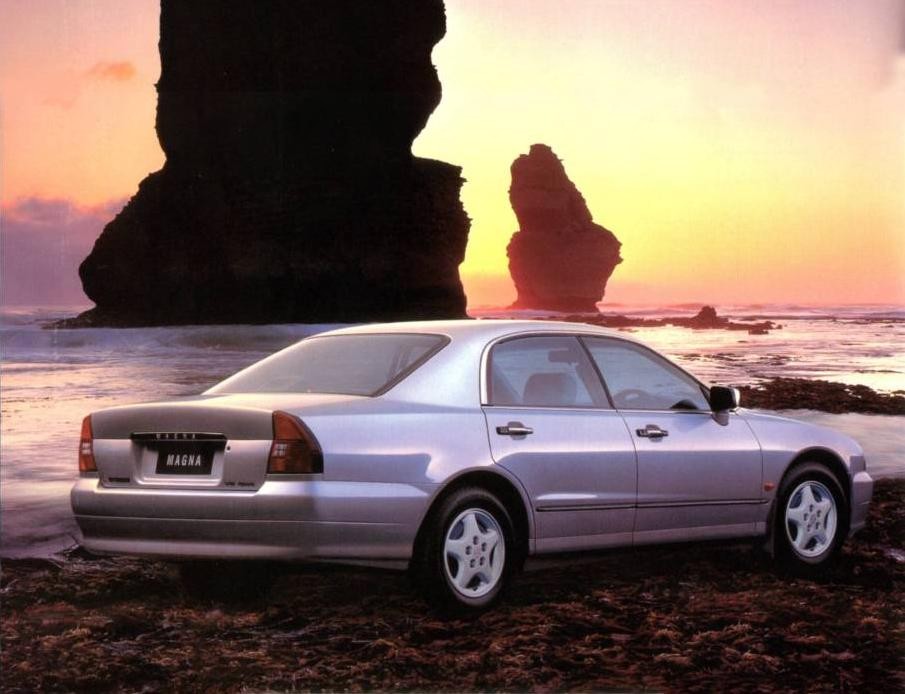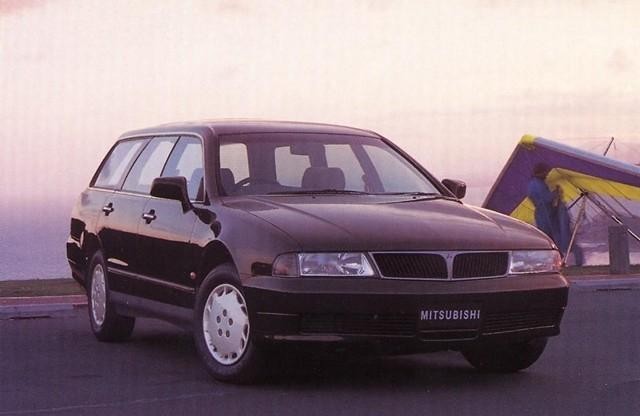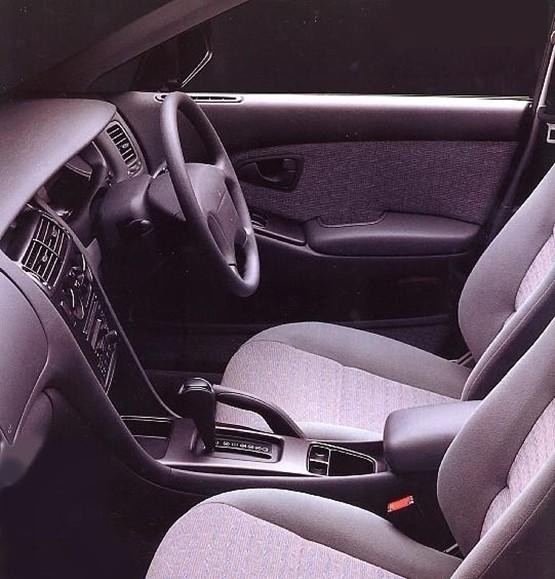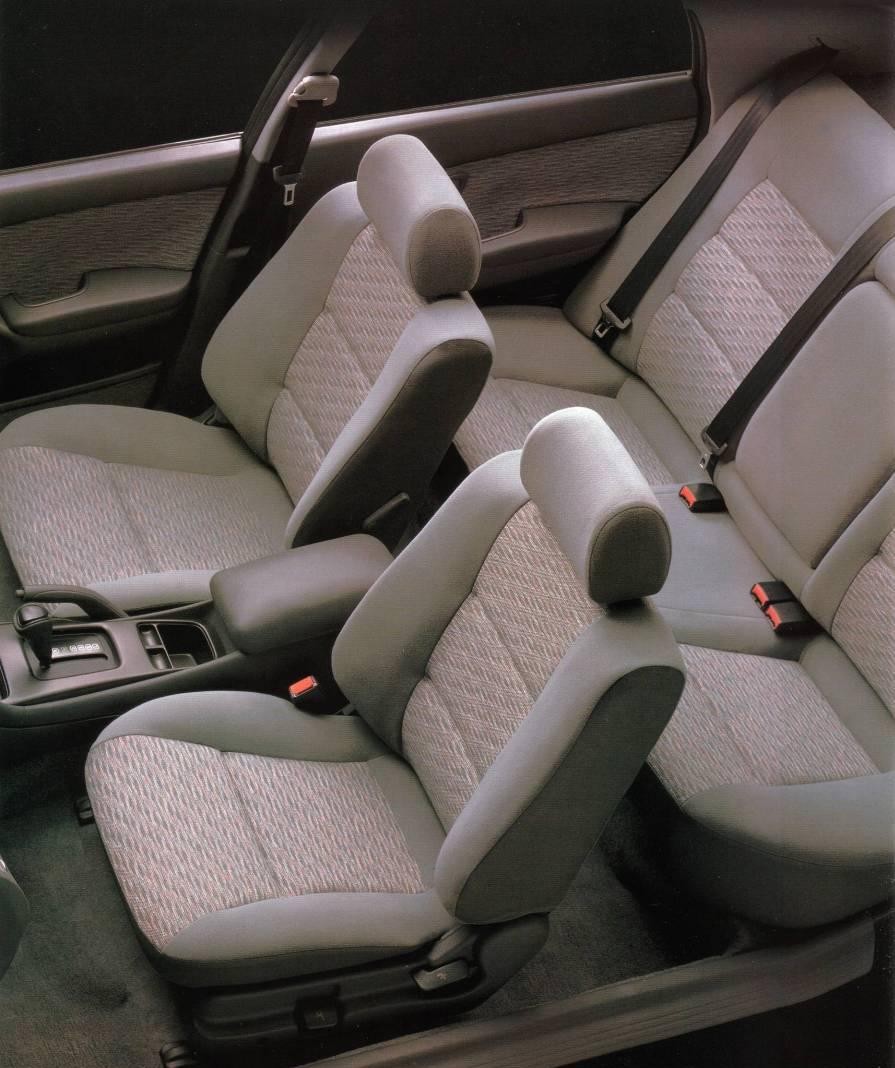
- Refined 3.0-litre V6 petrol engine
- Quiet, well-insulated cabin
- Impressive ride/handling balance
- Spacious interior for front occupants
- Steering lacks feel
- Large turning circle
- For 2.4-litre engine, occasionally clunky downshifts from automatic transmission
- Variable interior fit
Overview
Released in June 1997, the Mitsubishi TF Magna was available as a sedan or wagon. Manufactured at Clovelly Park, South Australia, the front-wheel drive TF Magna was available with either 2.4-litre four-cylinder of 3.0-litre V6 petrol engines. The TF Magna range initially consisted of four variants – the Executive, Advance, Altera and Altera LS – but was subsequently expanded with a Sports variant and the limited-run Solara.
4G64 and 6G72 engines
Of these engines,
- the 2.4-litre 4G64 engine had a cast iron block, single overhead camshaft, four valves per cylinder, compression ratio of 9.5:1; and,
- similarly, the 3.0-litre 6G72 V6 had a cast iron block, single overhead camshaft and four valves per cylinder, but its compression ratio was 9.0:1.
Transmission choices consisted of a five-speed manual or four-speed automatic unit, the latter with ‘Smart Logic’ programming which enabled it to adapt to driving conditions and style.
Developments over TE Magna
Compared to its TE Magna predecessor, the TF Magna introduced several minor upgrades, including new seat and door trim materials, a speed alert chime, upgraded keyless entry system (including remote boot release), cup holders, a mobile telephone power source plug and convex passenger-side mirror. The Advance and Executive variants were also fitted with new wheel covers.
Dimensions and suspension
The TF Magna sedan was 4785 mm long, 1785 mm wide, 1435 mm tall and had a 2722 mm long wheelbase. Relative to the sedan, wagon bodies were 26 mm longer (at 4811 mm) and 47 mm taller (1482 mm).
The TF Magna sedan had MacPherson strut front suspension with lower A-arms and an anti-roll bar and independent, multi-link rear suspension with upper and lower control arms. The TF Magna wagon, however, had a tubular rear axle with four trailing arms and a lateral locating rod.
| Body | Engine | Variants | Trans. | Peak power | Peak torque |
|---|---|---|---|---|---|
| Sedan | 2.4-litre petrol I4 | Executive | 4sp auto, 5sp man. |
105 kW at 5500 rpm | 205 Nm at 3000 rpm |
| 3.0-litre petrol V6 | Executive, Advance, Solara, Sports |
4sp auto, 5sp man. |
140 kW at 5500 rpm | 255 Nm at 4500 rpm | |
| Altera, Altera LS |
4sp auto | ||||
| Wagon | 2.4-litre petrol I4 | Executive | 4sp auto, 5sp man. |
105 kW at 5500 rpm | 205 Nm at 3000 rpm |
| 3.0-litre petrol V6 | Executive, Advance, Solara |
4sp auto, 5sp man. |
140 kW at 5500 rpm | 255 Nm at 4500 rpm | |
| Altera, Altera LS |
4sp auto |
Safety equipment
Within the TF Magna range, the Advance and Altera LS variants were equipped with dual front airbags and ABS.
ANCAP crash testing
In ANCAP crash testing, a 1999 TF Magna – that was not fitted with airbags – received a ‘marginal’ occupant protection rating. In the full frontal and offset crash tests, protection from serious head injury was poor for the driver and acceptable for the front passenger; protection from lower leg injury was also poor.
Features
Standard features for the Magna Executive included a four speaker sound system with radio and cassette player, speed alert, remote central locking, power mirrors, a height adjustable steering wheel, height adjustable driver’s seat and an immobiliser.
The Magna Advance was further equipped with cruise control, while the Altera added air conditioning, velour seat trim and power windows. Finally, the Magna Altera LS was distinguished by its 15-inch alloy wheels.
TF Magna Sports
In October 1997, the Magna range was expanded with the release of a Sports variant. Compared to the Executive, the Sports was differentiated by its 16-inch seven-spoke alloy wheels with 215/60 R16 high performance tyres, front fog lights, leather-wrapped steering wheel, brushed aluminium treatment for the instrument surrounds and rear deck spoiler; where fitted, the automatic transmission also had a sequential shift or ‘tiptronic’ mode. Furthermore, the Sports variant had revised suspension settings, including an 18 mm rear anti-sway bar (the Magna was not fitted with anti-sway bars), 11 per cent firmer rear springs, firmer upper control arm and trailing arm bushes and a 10 mm lowered ride height.
1998 Magna Solara
In May 1998, a limited-run Solara variant was released. Based on the Advance, the Solara was further equipped with 15-inch alloy wheels, air conditioning and unique interior trim.
Related links
